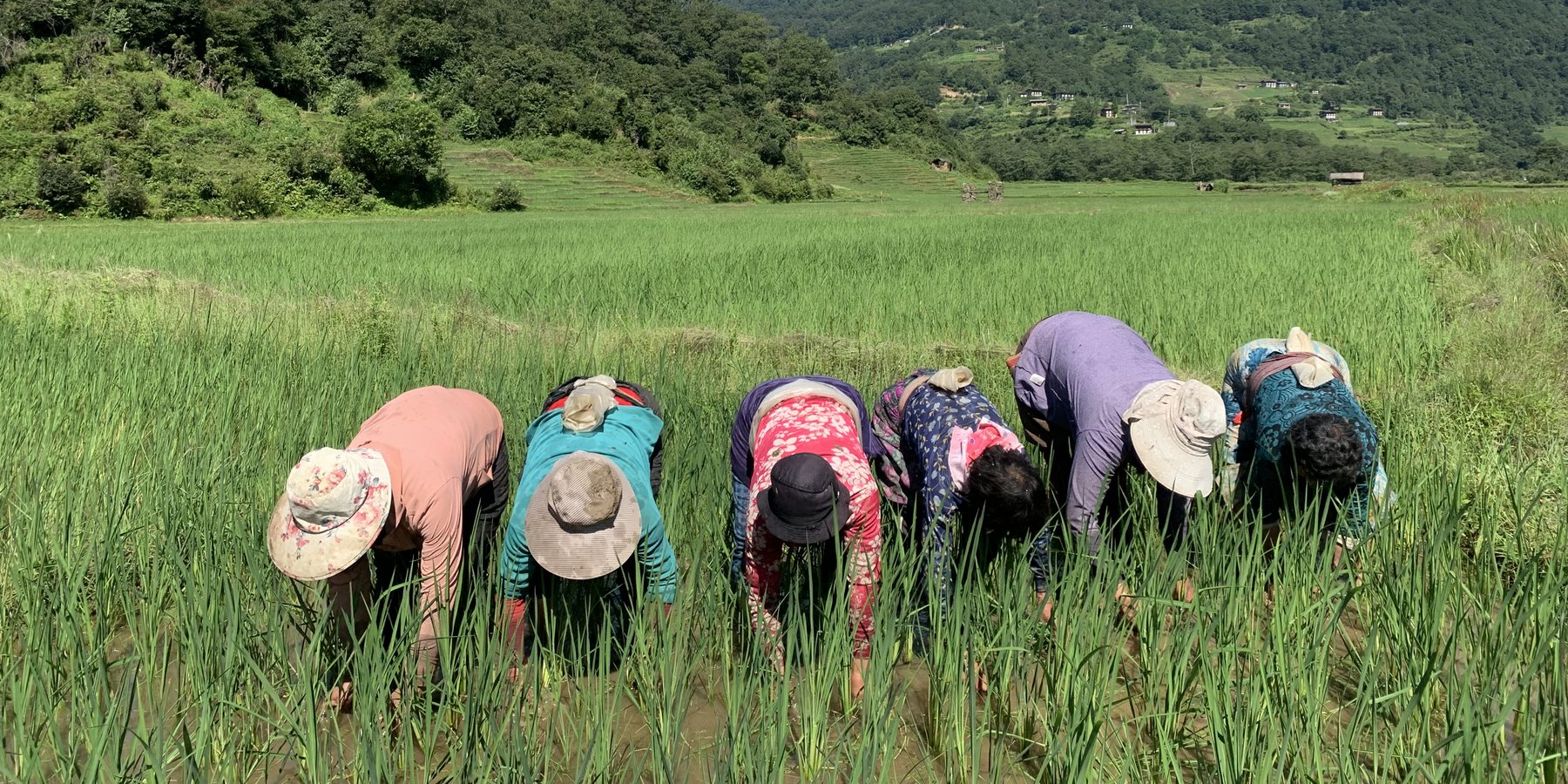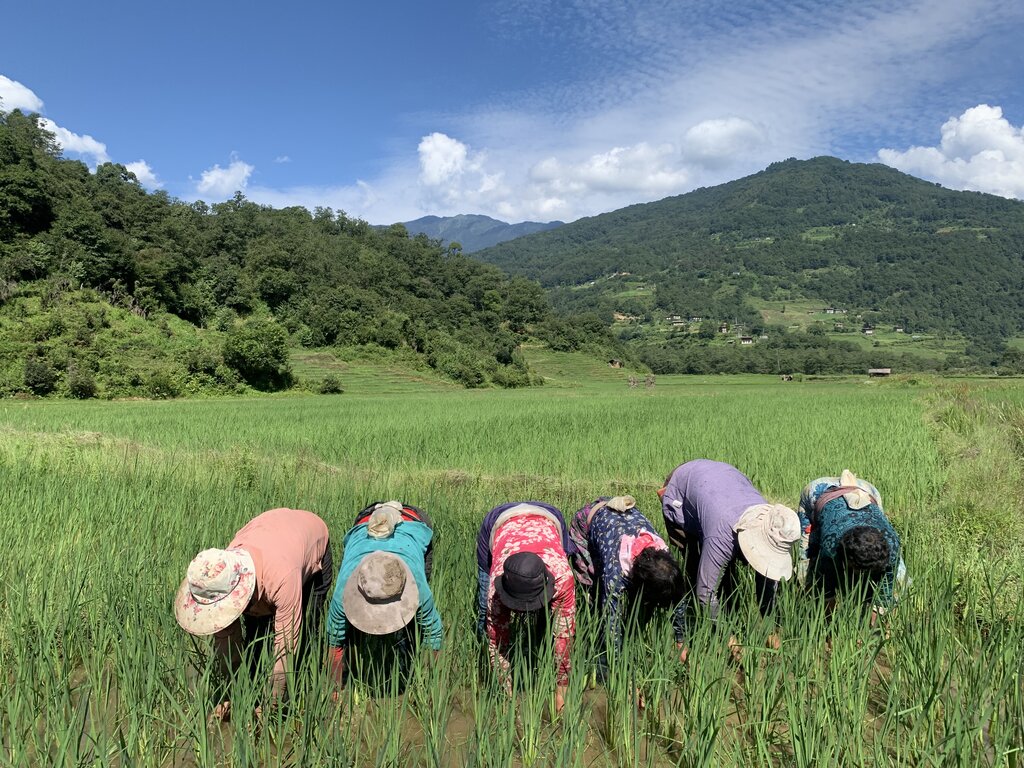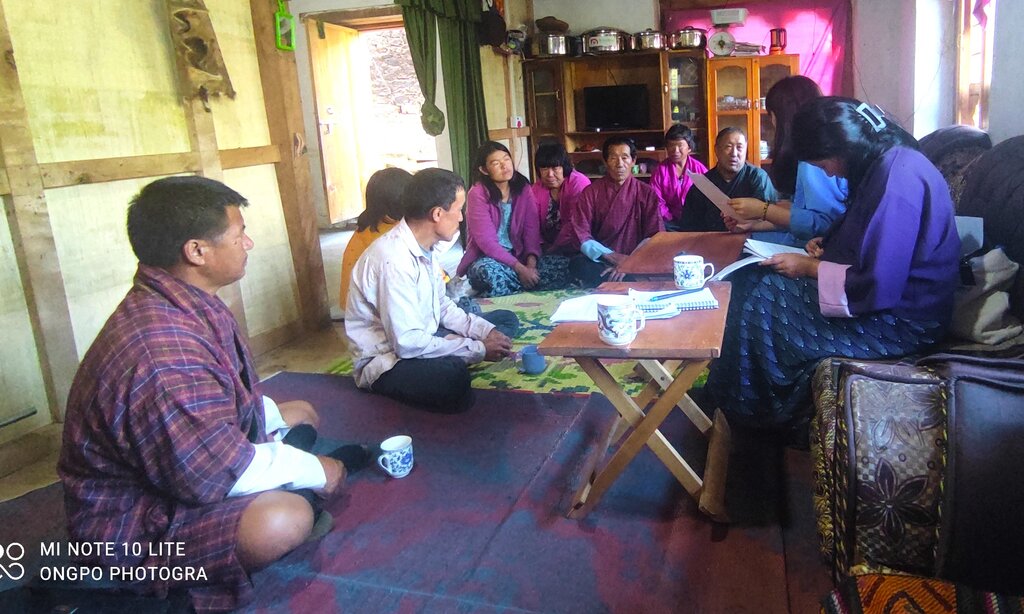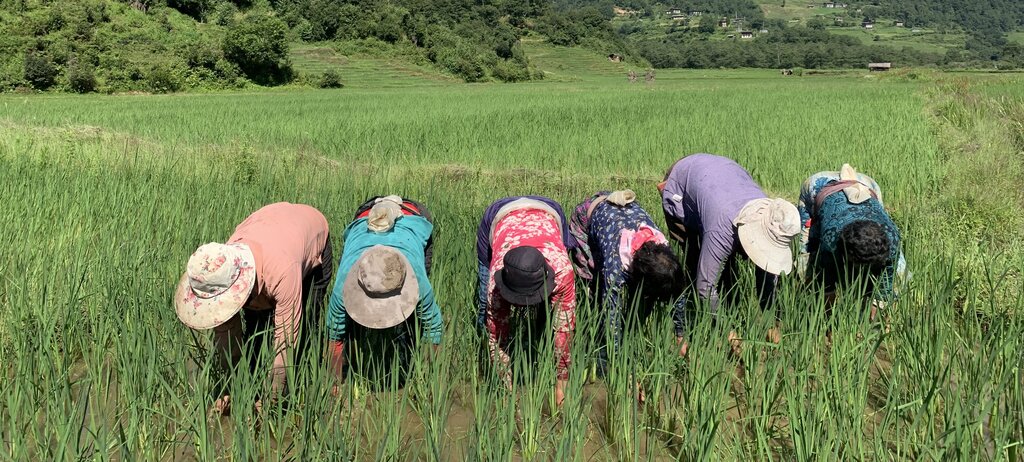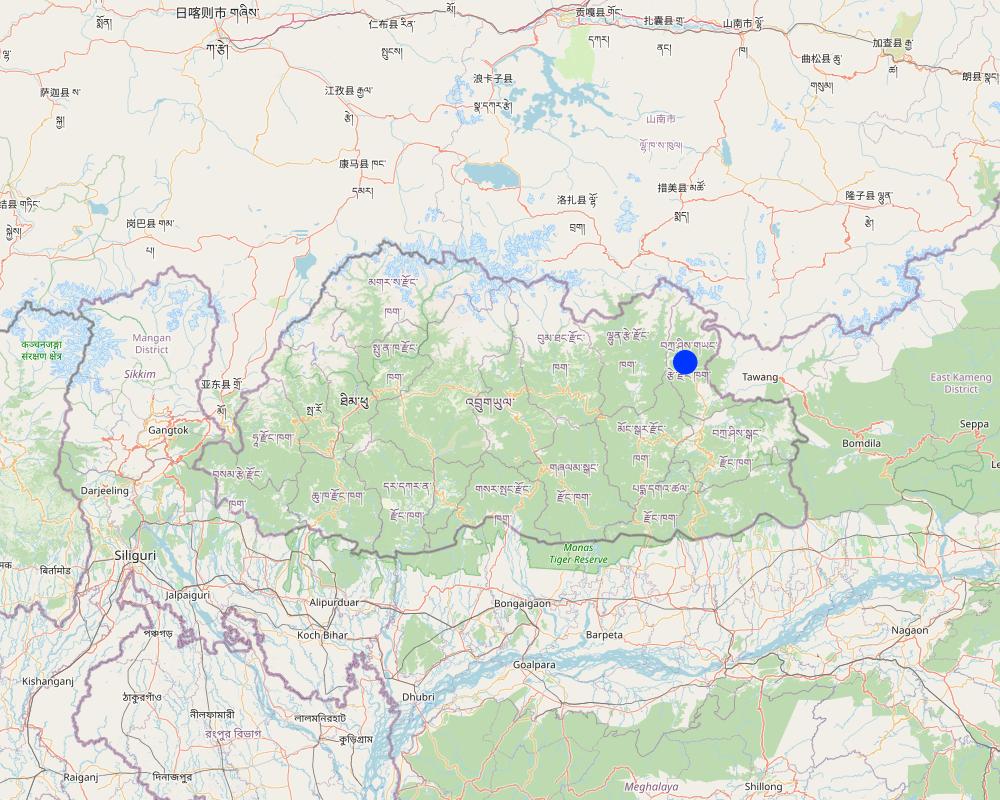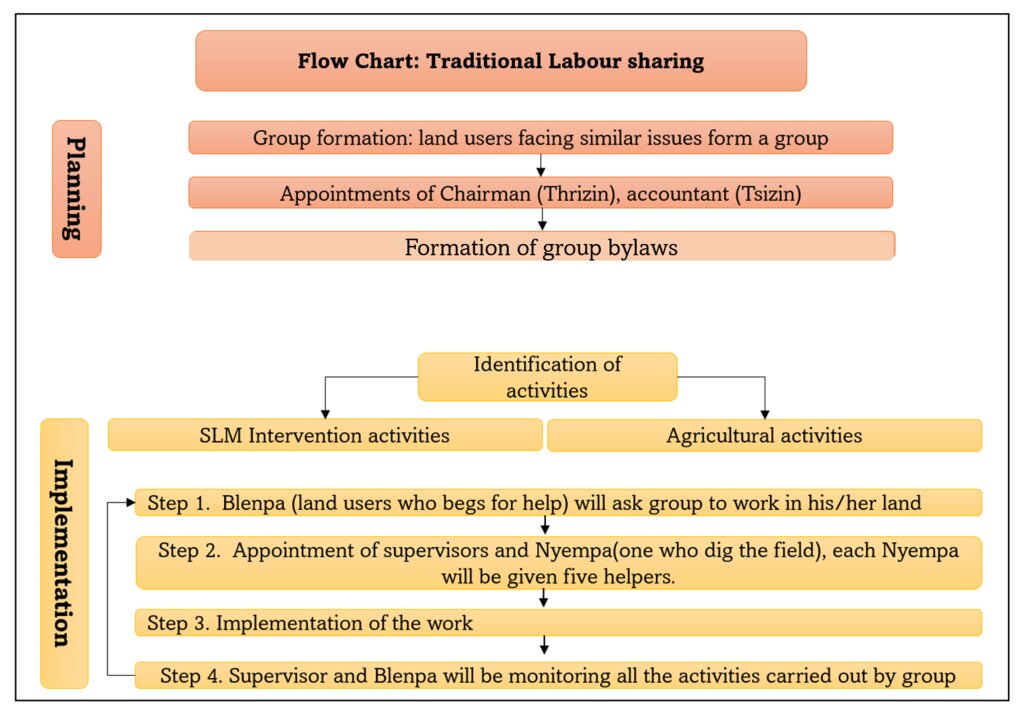Traditional labour sharing for farming [不丹]
- 创建:
- 更新:
- 编制者: ONGPO LEPCHA
- 编辑者: Tashi Wangdi
- 审查者: William Critchley, Rima Mekdaschi Studer
Latsab
approaches_6894 - 不丹
查看章节
全部展开 全部收起1. 一般信息
1.2 参与方法评估和文件编制的资源人员和机构的联系方式
关键资源人员
土地使用者:
Geduula
17324491
Namthurang wog, Betsamaang, Bumdeling, Trashi Yangtse District
不丹
土地使用者:
Dema Karma
17328742
Namthurang wog, Betsamaang, Bumdeling, Trashi Yangtse District
不丹
土地使用者:
Pelden Tshering
17371568
Namthurang wog, Betsamaang, Bumdeling, Trashi Yangtse District
不丹
土地使用者:
Tshering Gonpo
17559260
Namthurang wog, Betsamaang, Bumdeling, Trashi Yangtse District
不丹
土地使用者:
Wangmo Ugyen
17278903
Namthurang wog, Betsamaang, Bumdeling, Trashi Yangtse District
不丹
土地使用者:
Karma
17363810
Namthurang wog, Betsamaang, Bumdeling, Trashi Yangtse District
不丹
土地使用者:
Gurula
17718668
Namthurang wog, Betsamaang, Bumdeling, Trashi Yangtse District
不丹
土地使用者:
Choden Karma
17781323
Namthurang wog, Betsamaang, Bumdeling, Trashi Yangtse District
不丹
土地使用者:
Chozom Sither
17743907
Namthurang wog, Betsamaang, Bumdeling, Trashi Yangtse District
不丹
土地使用者:
Gonpo Tshewang
17705121
Namthurang wog, Betsamaang, Bumdeling, Trashi Yangtse District
不丹
有助于对方法进行记录/评估的项目名称(如相关)
Strengthening national-level institutional and professional capacities of country Parties towards enhanced UNCCD monitoring and reporting – GEF 7 EA Umbrella II (GEF 7 UNCCD Enabling Activities_Umbrella II)有助于对方法进行记录/评估的机构名称(如相关)
National Soil Services Centre, Department of Agriculture, Ministry of Agriculture & Livestock (NSSC) - 不丹1.3 关于使用通过WOCAT记录的数据的条件
(现场)数据是什么时候汇编的?:
20/7/2023
编制者和关键资源人员接受有关使用通过WOCAT记录数据的条件。:
是
2. SLM方法的描述
2.1 该方法的简要说明
In the past, it was difficult for households to complete seasonal farming activities like ploughing, sowing, and transplanting in time. So, land users came together by adopting 'latsab' or labour sharing. This involves pooling land users, who work on a rotational basis on the plots of the different group members. Labour sharing is a very old approach but is still being practiced throughout the country.
2.2 该方法的详细说明
该方法的详细说明:
In the past, it was difficult for households to complete seasonal farming activities like ploughing, sowing, and transplanting in time. So, land users came together by adopting 'latsab' or labour sharing. This involves pooling land users, who work on a rotational basis on the plots of the different group members. Labour sharing is a very old approach but is still being practiced throughout the country. In addition, land users also come together for any construction work or other activities related to land management. Labour sharing aims to complete seasonal farming activities more efficiently and on time. The approach also helps economically disadvantaged land users who cannot pay wages to employ. Other co-benefits reported are the improved sense of community and enhanced social cohesion because the exchange of experiences and collaboration builds mutual trust. Working in a group eases hard physical work, such as carrying and breaking large boulders, and is perceived to be much more enjoyable than working alone or in a household setting.
Groups are formed at the village and sub-village levels to enable households to take up labour-intensive SLM activities, such as stone bunding, bench terracing, stone check dam construction, water source protection works, or grass hedgerow development. Labour-sharing involves land users coming together to discuss important agricultural activities to be implemented. They also select the land users where the work should start. When it comes to activities related to SLM intervention, the land users are given initial practical training on the SLM intervention, which starts with hands-on work on the land of a group member, preferably that of a vulnerable household. Labour-sharing groups, therefore, facilitate the inclusion of vulnerable households, especially female-headed and small families, in the implementation of labour-intensive SLM interventions. In addition to technical guidance provided by extension staff, support is given to the group formation process, such as drafting informal by-laws and group management.
Any activities through a labour-sharing approach have to undergo specific stages. Initially, the land users will come together to discuss important agricultural or SLM activities to be carried out in a season. Secondly, they identify a 'Blenpa' who is a land user who requests help on his/ her land. Once in the field before they start any activities a supervisor or 'la pon' is appointed. If work involves heavy digging, a 'Nyempa' (preferably a strong man) is appointed, and he will be assisted by four or five women. The labour-sharing group is formed through common interests among different land users in the community. The group members come together and plan and prepare by-laws. They appoint a chairman or 'Trizin', who is the overall manager of the group. The accountant/treasurer or 'Tsezin' is appointed to take care of the finances. Any conflict between land users is solved within the group.
2.3 该方法的照片
2.5 采用该方法的国家/地区/地点
国家:
不丹
区域/州/省:
Namthrang wog (sub village), Betsamaang(village), Bumdeling(region), Trashi Yangtse(Provience)
Map
×2.6 该方法的开始和终止日期
若不知道准确的年份,请注明该方法的大致开始日期。:
50多年前(传统)
注释:
The exact date and year of initiation are not known as this approach has been practiced by their ancestors.
2.7 方法的类型
- 传统/本土
2.8 该方法的主要目的/目标
The main aims/objectives of the approach are 1) Labour-sharing to complete seasonal activities faster and on time, 2) To support economically disabled land users who cannot pay for hired workers, and 3) To share resources like water which is important for carrying out farming activities.
2.9 推动或妨碍实施本办法所适用的技术的条件
社会/文化/宗教规范和价值观
- 启动
All land users involved are from same ethnic group. They shared common social, cultural, and religious, norms and values. Implementation of any SLM activities was seen as enabling.
财务资源和服务的可用性/可得性
- 启动
Land users were accessible to financial resources and services as most of them are either members of a vegetable group or a Chilli group. As a member, they are privileged to avail loans.
参与者的的协作/协调
- 启动
The group formation is democratic and the leader selected to regulate the group was selected by land users themselves. Therefore, strong collaboration is observed.
了解SLM,获得技术支持
- 启动
Land users are aware of SLM interventions like terracing, bunding, stone bunding, growing Napier grass, etc. These indicated that they have good knowledge and are accessible to technical support from SLM specialists.
市场(购买投入,销售产品)和价格
- 启动
Land users indicated that they have a good market for their produce like chilli and potatoes. They have a group that deals with marketing.
工作量、人力资源可用性
- 启动
Land users are happy that the current approach of labour-sharing helped them a lot when it comes to workload and labour shortage. Although if there are fewer household members, the approach helps them to carry out important agricultural activities in time.
3. 相关利益相关者的参与和角色
3.1 该方法涉及的利益相关者及其职责
- 当地土地使用者/当地社区
10 households were involved out of which 6 are females and 4 are male. They are mostly from the age group between 40-60 years old, All of them are married and are economically disabled. All of them belong to the same ethnic group known as
Land users are involved in the planning of by-laws, and implementation of activities, Elected chairman is responsible for the smooth functioning of the group. The accountant takes care of the finances. Any conflict between land users is solved within the group.
- SLM专家/农业顾问
Extension agent
He/she is not part of the group but is involved whenever he/she needs assistance from the group. He/she acts as an SLM specialist at the village level.
3.2 当地土地使用者/当地社区参与该方法的不同阶段
| 当地土地使用者/当地社区的参与 | 指定参与人员并描述活动 | |
|---|---|---|
| 启动/动机 | 自我动员 | The labour-sharing approach was initiated by the ancestors of current land users. Current land users found this approach as an effective way to mitigate labour shortage and resource management and they continue to preserve and practice it. |
| 计划 | 自我动员 | Land users are the ones who come together, prepare their by-laws and plan all the activities related to farming or SLM intervention. |
| 实施 | 自我动员 | The approach has an elected chairman and accountant who are responsible for the smooth running of the group and finances. Any conflicts that arise between land users are solved within the group. |
| 监测/评估 | 自我动员 | The group is monitored by the chairman. During the time of any activities, they also appoint a supervisor who will monitor the quality of the work performed by the members. |
3.3 流程图(如可用)
具体说明:
Flow chart created following conversation with the group. There are two important phases, initially planning which includes group formation, and by-law, and the second phase is the implementation phase.
作者:
Ongpo Lepcha
3.4 有关SLM技术选择的决策
具体说明谁有权决定选择要实施的技术:
- 主要是土地使用者,由SLM专家提供支持
解释:
The technologies implemented by land users have been decided by land users and upon their request to the government the SLM specialist are sent and technology related training and materials are provided to the group.
4. 技术支持、能力建设和知识管理
4.1 能力建设/培训
是否为土地使用者/其他利益相关者提供培训?:
是
明确受训人员:
- 土地使用者
培训形式:
- 示范区域
涵盖的主题:
Improved ways to dry Chilli, Nursery bed preparation, electric fencing, Growing Napier grass, Chainlink fencing, Greenhouse construction, etc.,
注释:
The training was provided by extension agents
4.2 咨询服务
土地使用者有权使用咨询服务吗?:
是
说明/注释:
Whenever there is an outbreak of crops or livestock diseases, advisory services are provided by agricultural and livestock officers on do and don't of the issues.
4.3 机构强化(组织发展)
是否通过这种方法建立或加强了机构?:
- 是,非常
具体说明机构的强化或建立程度:
- 本地
说明机构、角色和职责、成员等。:
Within the labour-sharing group, land users also have formed other groups like the Chilli group (focusing on cultivating and marketing chilli), Vegetable group (involved in growing and marketing vegetables other than chilli)
具体说明支持类型:
- 财务
- 能力建设/培训
- 设备
提供进一步细节:
The financial institution provides loans to those land users who are members of the group. Support from the government and external projects targeted to the groups. As a result, members of the group have received training in Chilli drying through the Tarayana Foundation. Members also shared that when they work in groups they also share tools, equipments, machinary, etc., which indirectly reduces the cost.
4.4 监测和评估
监测和评估是该方法的一部分吗?:
是
注释:
Labour sharing involves working on a rotation basis. The group has a chairman who monitors the overall activities of the group. When it comes to agricultural or SLM intervention activities carried out at individual land user's fields. The supervisor is appointed who monitors and supervises the work.
若是,该文件是否用于监测和评估?:
否
4.5 研究
研究是该方法的一部分吗?
否
5. 融资和外部物质支持
5.1 该方法中SLM组成部分的年度预算
注释(例如主要的资助来源/主要捐助者):
The group is mainly formed by those land users who are economically disabled. They work on a rotation basis so that they don't have to pay for human resources involved in carrying out any agricultural or SLM intervention activities.
5.2 为土地使用者提供财政/物质支援
土地使用者是否获得实施该技术的财政/物质支持?:
是
如果是,请具体说明支持的类型、条件和提供者:
Electric fencing: The materials were supported by the government.
Chilli dryer:
5.3 对特定投入的补贴(包括劳动力)
- 设备
| 具体说明哪些投入得到了补贴 | 程度如何 | 对补贴做出具体说明 |
|---|---|---|
| Chilli Dryer | 充分融资 | They received one dryer from the Women's Division under the National Commission for Women and Children (NCWC). |
- 建筑
| 具体说明哪些投入得到了补贴 | 程度如何 | 对补贴做出具体说明 |
|---|---|---|
| Electric fencing | 充分融资 | All the materials required for electric fencing were provided by the Bhutan government. |
- 基建
- 其它
| 其它(具体说明) | 程度如何 | 对补贴做出具体说明 |
|---|---|---|
| Green house | 部分融资 | The total cost for greenhouse materials was shared between individual land user and the government. 30% of the total cost is borne by land users and 70% by the government. |
如果土地使用者的劳动力是一项重要的投入,那么是不是:
- 获得其他物质支持
注释:
All materials required were supplied by the government for free. Land users were involved in construction/installation.
5.4 信用
是否根据SLM活动的方法给予信用值?:
否
5.5 其它激励或手段
是否有其他激励措施或工具用于促进SLM技术的实施?:
是
如果是,请具体说明:
The group also received a cake-making machine. However, this was shared among different groups from other places.
6. 影响分析和结论性陈述
6.1 方法的影响
该方法是否有助于当地土地使用者,提高利益相关者的参与度?:
- 否
- 是,很少
- 是,中等
- 是,支持力度很大
Yes, the approach has empowered local land users. Gender equality is maintained and Chairmanship is done on a rotation basis. The work done by the group is supported by government and other external projects.
该方法是否帮助土地使用者实施和维护SLM技术?:
- 否
- 是,很少
- 是,中等
- 是,支持力度很大
The group is basically focused on agricultural activities and to protect their crop from wildlife they have installed electric fencing. They also rear dairy as a source of manure to improve the fertility of the soil.
该方法是否提高了土地使用者实施土地管理的知识和能力?:
- 否
- 是,很少
- 是,中等
- 是,支持力度很大
Government and external support is directed to the group because it is quite cheaper than providing to individual land users. Any kind of capacity development related to agricultural activities or SLM intervention is given to the group. Group members also shared that they received training in various fields of SLM like stone bunding, Terracing, Electric fencing, greenhouse construction, and improved dairy shed construction.
该方法是否缓解了冲突?:
- 否
- 是,很少
- 是,中等
- 是,支持力度很大
Establishment of the electric fencing solved human-wildlife conflicts. Irrigation water used to be an important issue for conflict in the past. However, group formation has helped the community improve their irrigation by improving source and also scheduling irrigation timing among the members.
该方法是否有助于社会和经济弱势群体?:
- 否
- 是,很少
- 是,中等
- 是,支持力度很大
The group consists of members who are economically disabled. The group has helped them to sustain their livelihood as any agricultural activities are carried out in time. The members also don't have to pay for labours which otherwise is very expensive. Working together also builds a sense of belongingness and closeness among the members.
该方法是否改善了市场准入?:
- 否
- 是,很少
- 是,中等
- 是,支持力度很大
The members of the Labour-sharing group are also members of other groups like the Chilli and Vegetable group. This has helped them to market their produce.
6.2 土地使用者实施SLM的主要动机
- 增加生产
Every agricultural activity carried out by the group is monitored thus improving the conditions in which a crop grows, thus increasing production.
- 增加利润(能力),提高成本效益比
Members of the group work on a rotation basis thus reducing production costs and increasing the cost-benefit ratio.
- 减少土地退化
Agricultural activities are done manually thus reducing land degradation.
- 降低灾害风险
Agricultural activities are seasonal and every activity has to be done in time. Labor-sharing groups helped members to complete these activities in time thus reducing the risk of disaster.
- 减少工作量
Group members come together and work for a common goal thus reducing workload.
- 冲突缓解
Member shared that conflict that arises due to irrigation water is no more.
6.3 方法活动的可持续性
土地使用者能否维持通过该方法实施的措施(无外部支持的情况下)?:
- 不确定
若否或不确定,请具体说明并予以注释:
The approach was there in the past when external support was not there. It is continuing today, but it is uncertain whether this approach will survive in the future with changing climate and improving the lifestyle of every farmer.
6.4 该方法的长处/优点
| 土地使用者眼中的长处/优势/机会 |
|---|
| The approach allows members to enhance social cohesion and community sense. They come together for any kind of work, thus tackling the main issue of labour shortage and easing hard physical work. |
| Agricultural activities like ploughing, tilling, sowing, transplanting, weeding, watering, and harvesting, have to be completed on time. The approach allows every member to complete these activities on time avoiding crop failure and enhancing crop production. |
| The approach includes all vulnerable groups giving them opportunities to share their problems and supporting them through labour-sharing to carry out important agricultural activities for crop production. |
| 编制者或其他关键资源人员认为的长处/优势/机会 |
|---|
| The approach demands equal participation from all household members. Thus giving training on any SLM intervention activities by SLM experts becomes very easy. It is also easy to communicate to the group for dissemination of any information. |
| The approach helps the economically disabled members to sustain their livelihood. This is because labour-sharing cut many of the costs involved in crop production or SLM intervention activities increasing the cost-benefit ratio. |
6.5 该方法的弱点/缺点以及克服它们的方法
| 土地使用者认为的弱点/缺点/风险 | 如何克服它们? |
|---|---|
| Marketing of agricultural produce: There are many other groups at the village and sub-district level. They compete to capture the local market which is always saturated with supply. Exploring the market at the domestic and international levels is very expensive for the majority of the group. | The government takes some initiative to explore the market for these groups or give them some incentives to do marketing like marketing van. |
| 编制者或其他关键资源人员认为的弱点/缺点/风险 | 如何克服它们? |
|---|---|
| The sustainability of the group: Most of the members are between the age group of 40-70. The young generation is not interested in agriculture and in the future, there are chances that this kind of group may die. | The government must take some initiative to make our young generation like Agriculture by bringing new technologies that will ease hard human labour. |
7. 参考和链接
7.1 方法/信息来源
- 实地考察、实地调查
Three sites were visited to see the group working.
- 与土地使用者的访谈
10 land users representing 10 households were interviewed.
- 根据报告和其他现有文档进行编译
5
7.2 参考可用出版物
标题、作者、年份、ISBN:
BHUCAT (Bhutan catalogue of soil and water conservation approaches and technologies):Best practices and guidelines from Bhutan for sustainable land managements on steep to very steep slopes, National Soil Service Center, Department of Agriculture, Ministry of Agriculture and Forest 2012,
可以从哪里获得?成本如何?
A copy of a book was provided by National Soil Service Center, Simtokha: Bhutan for Free.
标题、作者、年份、ISBN:
2021 Labour force survey report Bhutan, National statistics Bureau, 2021, ISBN 978-99936-28-93-4
可以从哪里获得?成本如何?
available online for free. https://www.nsb.gov.bt/wp-content/uploads/dlm_uploads/2022/04/LFS-2021-web.pdf
7.3 链接到网络上可用的相关信息
标题/说明:
SLM Labour-sharing group Bhutan
URL:
https://qcat.wocat.net/wocat/approaches/view/approaches_2491/
标题/说明:
Sharing labour to implement contour bunding in Nepal
URL:
https://qcat.wocat.net/wocat/approaches/view/approaches_2604/
标题/说明:
Organic agriculture, Labour exchange, and social networks: a case study of smallholder farming in Bhutan
URL:
https://link.springer.com/article/10.1007/s13165-022-00416-z
链接和模块
全部展开 全部收起链接
无链接
模块
无模块


